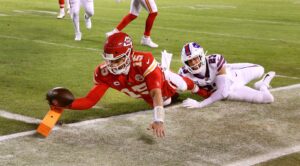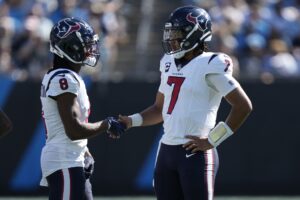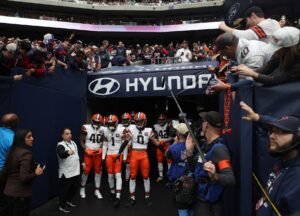The NFL season is brutal, poignant, and unforgiving, akin more to a harsh snow storm than a run on the beach. One mistake along the way, and teams are forced into must win games to recover. Last week, the Kansas City Chiefs saw their second ‘must win’ game against the Los Angeles Chargers. Based on the Chiefs play, hope for the playoffs was waning. Yet, they won as the offense pivoted with efficiency underlying their modus operandi. This last week against the Miami Dolphins did not fit the ‘must win’ narrative due to the juxtaposition of overall talent. However, to win the AFC West, beating the Dolphins was a necessity.
And beat the Dolphins they did, finally accomplishing momentum and showing resiliency when it mattered. The overt narrative on the game is the Chiefs first AFC West championship in back-to-back seasons in franchise history while being the second team since 1981 to have a 4,000-yard quarterback, a 1,000-yard tight end and wide receiver, and a 1,000-yard running back. But creeping under those lines is the Chiefs arising from the snow storm due to efficiency preserving their life. Under the scrutiny that is the NFL season, the Chiefs dug to their roots of efficiency and came out alive – the Kansas City Chiefs week 16 stats reveal that notion, and provide a spectrum of equal hope and concern for the playoffs.
Kansas City Chiefs Week 16 Stats and Charts – Efficiency and Resiliency
Chaos Theory
(At this point in the season, it might be a good time to revisit the concept of chaos theory. In week one, the mathematical debauchery was explained as essentially a fractal graph that assigned value to outcomes in a game, defining which team had more momentum or chaos control.)
The Chiefs spent Christmas Eve in their regular season finale at Arrowhead Stadium. Under the jovial Christmas spirit, the Chiefs fans supported their team, and the defense did not disappoint. The Chiefs continued a trend of aggressive tilt off the bat by forcing a fumble on the Dolphins first drive, continuing a trend which saw landing sacks in the opening of the past two weeks.
Derrick Johnson hammered Jarvis Landry on a third and six, forcing a fumble, with Marcus Peters right on point to recover. The most resounding point on this play may have been the fumble, but its causation only came thanks to the entire Chiefs defense swarming to the ball and being ready to play, a theme that continued for part of the afternoon.
The Chiefs offense took the football and only managed a field goal. Again, a repeating theme of an offense that has a hard time capturing momentum. No matter, the next time the Chiefs got the ball, Alex Smith was not only efficient, but proficient. Using Travis Kelce and Tyreek Hill, Smith punctured the Dolphins directly over their most refined unit – safety Reshad Jones. Kelce continued the aggressive theme by catching a nine-yard pass directly over Jones.
Although the Dolphins managed a field goal on their next drive, the Chiefs responded again to take a 17-6 lead and force chaos into their hands. Kareem Hunt not only was running, but forcing the Dolphins into disarray everywhere of the field. Ndamukong Suh finished the day with no tackles, implicating the ferocity the Chiefs offensive line set early in the first half.
However, the Chiefs defense gave up an eye-rolling touchdown right as the offense began to assert chaos. Wide receiver Jakeem Grant caught a short screen pass, broke two tackles, and ran 65 yards for the score. The underlying implication is the rapid succession of events that occur within the Chiefs defense. A failure to tackle and thus the propagation of explosive plays has dampened the offense, and forced them into a corner.
The Chiefs offense, even when not intrinsically able to play from behind due to the importance calling running plays, has been overwhelmingly efficient under Matt Nagy’s control. Having the ball five times in the second half, the Chiefs netted field goals on three of those, and missed another.
The one drive the Chiefs failed to score on was important for the chaos model. The score was 23-13, and the Chiefs had the ball on a fourth and inches after failing on a third and short the play before. With the ball on the Dolphins 19-yard line, Nagy opted to attempt another run.
Modeling this play is an intriguing experiment in modeling possible playoff decisions from the Chiefs staff. A field goal could have put the Chiefs up 26-13 with roughly three to four Dolphins drive opportunities left – or, a 60-percentile win window. Converting the fourth down would have taken the Dolphins drives opportunities down to three due to time of control, or a 55-percentile win window.
Failing the conversion, which the Chiefs did, however, would be more emblematic of missed opportunity than the Dolphins opportunities to win rising. In the chaos model, the failure kept the Chiefs chaos in balance – hence, the risk was worth it. Had they converted the fourth down and the Chiefs continued to drive and scored a field goal, the chaos would have been 65 to 70 percent. Had the Chiefs scored a touchdown, they would have had 75 percent control juxtaposed to merely 60 percent by settling for a field goal on the fourth and inches. The underlying reason for attempting the fourth down was the premise the opportunities and time a conversion would have taken from the Dolphins.
Mathematically, the risk was worth taking. Fortunately, despite the decision not going their way, the Chiefs defense forced a fumble on the next drive and rose their control to 70 percent anyways. Just as if some fate, or objective trend on the afternoon, was playing out. Nagy had reason to trust his defense this afternoon. Micro trends are just as important as macro trends.
Preservation by Efficiency
The Chiefs offense, as discussed in the fourth-down risk implications, has been overwhelmingly efficient. They had the ball five times in the first half, scoring on four, while having the ball six times in the second half, scoring three times and being in position to score four times. (The sixth possession was a mere kneel down).
Harrison Butker will be essential for the Chiefs in the playoffs. Although the offense has trouble finishing drives, if they can net field goals and score in their time of possession, they will be competitive. Much in the same line as Butker’s importance, the entire offensive line will be essential to scoring more touchdowns than field goals.
On the season, the Chiefs have a convex scoring ratio, 37 offensive touchdowns to 39 made field goals. No team in the past decade has won the Super Bowl with a one-to-one ratio, much less be competitive in the playoffs.
That final conversion of efficiency begins with the Chiefs offensive line. Although Hunt had a good day, he had to run 29 times in order to gain 91 yards. Considering one of those runs was 24 yards, the missing point in this game was running throughout the tenure of the game. In the playoffs, the Chiefs offensive line needs to ensure 29 attempts turns to a minimum of 102 yards, but ideally 116 yards (3.5 yards per carry for a minimum of conversion, four yards per carry is ideal for efficiency).
The members of the Dolphins secondary had 16 tackles, with 11 coming form Jones. Jones had a phenomenal game in coming up and assisting the front seven in containing the box. Without his aggressive play, Hunt may have had a plethora of more explosive runs. Consider the ideal scheme for the Dolphins is the run stops at the front four, that company had only 12 rush tackles among more players. Hence, there was penetration, but Jones deserves praise for an all-out effort.
Smith had another day of hyper efficiency on the deep ball, a subjugate of the play calling. He had to attempt only eight deep passes, completed four of them, and gained 138 yards. The play calling worked for both tight ends, and although Orson Charles was utilized as a decoy route, he had a pivotal 35-yard catch. Hill’s speed led to two receptions for pivotal 52-yard and 33-yard passes. The potency of schemes to use multiple cones of the field will be essential to playoffs.
The metric should have been five receptions on eight targets. Albert Wilson had a devastating drop in the end zone. Wilson had a decent day, but needs to catch all his targets in the short range. Schematically, he carries the onus of the under routes. Securing only three of seven targets in that range will not carry success in the playoffs.
The responsibility in the end falls back on the entire team. From decoy routes to Smith making precision throws, the onus is on every player to fulfill their role.
Turnovers and Not Much Else
Defensively, the Chiefs held the Dolphins to 13 points in the ugliest of fashion. The Dolphins managed 6.4 yards per play – with six yards per play a mark that has netted teams an 87-41 record so far in 2017. Time and time again, the Chiefs gave up explosive plays for a total of 13 passes and two runs – much of them were short passes resulting in missed tackles, with Ron Parker a particular standout on errors.
The Dolphins run game was bottled up by linebackers and kept from ever getting to be sustainably explosive. The Chiefs secondary only had to make three of 16 rush tackles. Even more important, the defense stepped up when needed and kept the Dolphins from converting a third down.
The juxtaposition of 6.4 yards per play but zero for eight on third downs paints the most concise picture of the game. The Dolphins were able to generate yards after the catch, but fell short due to a lack of conversion, time of possession (22 minutes), and abysmally self-destructive 11 penalties for 75 yards.
Smokin’ Jay Cutler was not wholly accurate on the day, and turned to his receivers to generate yardage. Grant deserves commendation for gaining 107 yards on four receptions. Marcus Peters had an outstanding game when it came to locking down deep routes while forcing his way into picking the pockets of the Dolphins receivers. Although Steven Nelson was soft on the under routes, he too kept everything in front of him and never broke.
Cutler ought to have scored more, but in the end one reception on eight deep targets is reminiscent of forced deep passes. The most successful passing came on the left side, where Grant was 3/3 and Landry was 3/4 on 32 yards receiving.
Conversely to the explosive plays given up in the passing game, the Dolphins run game was forced into a premature death. Kenyan Drake managed 57 yards on 13 attempts, with his longest run as 18 yards. Johnson did an excellent job of keeping Drake in check on Cutler’s check-downs as well. Drake had no receptions on three targets.
The synthesis of the Chiefs defense comes in forcing teams to misalign from their game plan, and thus abandon some aspect of it. The prime example against the Dolphins was forcing Cutler to launch passes without the comfort of time to operate a running game. Drake was forced to run in the middle of the field on all but one exterior sweep play which netted the long 18-yard dash.
As a unit, the Chiefs defense is succeeding, but under the pretense of forcing turnovers – dual implicative stat line. First, turnovers are part and parcel to a luck metric, but, second, do show aggressiveness in the demeanor. However, in the playoffs, turnovers are rare against teams which play fundamental football.
Sacks are a more secure metric for the Chiefs defense to fall back onto. Sacks are also completely erratic for the Chiefs with none on Sunday and no quarterback hits, an implication of a fundamental flaw in the defense.
Consider the importance of netting more success than just off turnovers in these metrics. Since 1970, there have been 900 teams playing in playoff games. 532 teams, or 59 percent, have committed double turnover games. An argument could be made the NFL has improved since 1970, so begin at the year 2000 and 352 teams have played in playoff games. Only 175 teams, or 50 percent, have committed double turnover games. In other words, a defense which succeeds primarily off forcing turnovers might as well flip a coin; hardly a pattern of sustained success.
Main Image:






